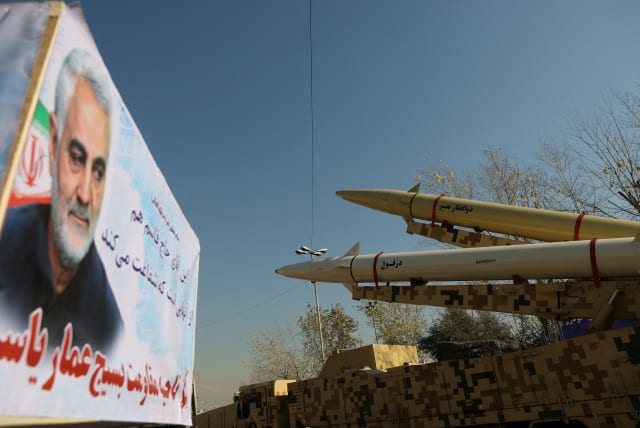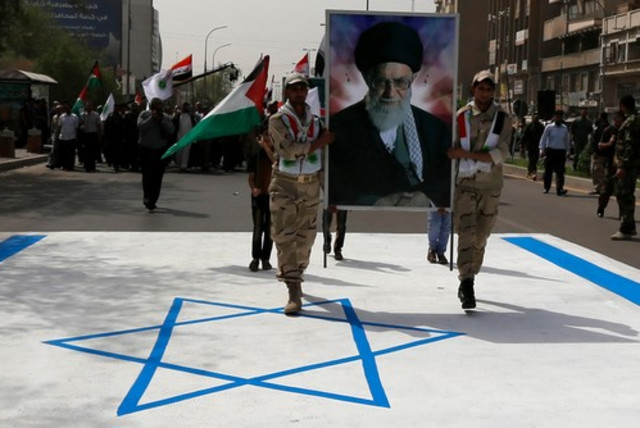Mysterious explosion highlights threats of Iraqi Shi'ite militias - analysis

Who are the Iranian-backed militias in Iraq who threaten Israel, the US, and the region?
An explosion at a site used by Iranian-backed Shi’ite militias in Iraq has focused a spotlight on the role that these groups play in Iraq and their threat to the region.
The site of the explosion is around 50 km. north of Baghdad overnight Friday, includes a hangar and several concrete walls, and is part of a compound used by the Iraqi-based Popular Mobilization Units, a group of militias that are generally linked to Iran. These groups are mostly made up of Shi’ites, but some include other Iraqi religious and ethnic groups.
Militiamen investigated a large crater after the explosion. The Iraqi authorities appeared to indicate that they did not detect any planes or drones in the area prior to it. Iraq is therefore downplaying the mysterious explosion.
The Iranians also downplayed reports of an Israeli airstrike on Friday. Iran wants to downplay any incidents that appear to be a setback for the Islamic Republic or its proxies and allies. Nevertheless, experts who follow Iraq and open-source intelligence analysts have concluded that the explosion seems to have taken place where a container was located that may have housed munitions.
The question is, who are these Iraqi-based Iranian proxies and allies? The militias in Iraq have deep roots tied to Iran. For instance the Badr Organization, which is linked to the militias, has its origins in the 1980s when it was working alongside the Islamic Revolutionary Guard Corps in opposition to Saddam Hussein’s regime. Abu Mahdi al-Muhandis, a leader of Kataib Hezbollah in Iraq, who was killed in 2020 by a US drone strike, also earned his spurs in the 1980s working with the Iranians. These groups are tied to Hezbollah and other Iranian-backed groups in the region.
In the aftermath of the 2003 US invasion of Iraq
The Iranian-backed militias in Iraq expanded after the US invasion in 2003. They benefited from the fall of Saddam Hussein, and within a few years, they grew exponentially and began to take on more official roles in Iraq because the militias were tied to political parties.
In 2014, when ISIS invaded Iraq, the militias got another boost when Shia cleric Muqtada al-Sadr issued a fatwa calling on young men to fight ISIS. The volunteers were funneled into units by the militias, expanding their force to more than 100,000 men. When the war on ISIS was over, the militias were able to get official funding as a paramilitary organization. This cemented their official role.
As such, the militias were able to stockpile more weapons and control military compounds in an official capacity. For instance, the site called “Kalsu” north of Baghdad where the explosion took place was formerly used by the US as a military base, and then handed over to the Iraqis, who let the militias use it.
WHEN ISIS was largely defeated in Iraq in 2017, the militias set their sights on controlling the Iraq-Syria border. On the Syrian side at Albukamal the Iraqi militia Kataib Hezbollah set up its headquarters. Later, the Iranians swooped in and built a base near Albukamal.
In 2018, reports said that the militias were moving ballistic missiles to Anbar in western Iraq. Tensions rose that year and the next as the militias increased their anti-Israel rhetoric.
The leader of the Asaib Ahl al-Haq militia, Qais Khazali, threatened Israel from Lebanon. The militias put out statements saying that they would join in any future war between Israel and Hezbollah or Iran. This came as Tehran said it was weaving a number of “arenas” against Israel, a reference to creating a multi-front war against the Jewish state using forces in Iraq, Syria, Lebanon and Yemen.
The next step for Iran was to mobilize the militias to attack US forces in 2019. The militias also ratcheted up the rhetoric against Israel, accusing it of targeting Iraq in 2018 and 2019.
The militias often fired 107mm. rockets at US forces in Iraq, which led to the US assassination of IRGC Quds Force head Qasem Soleimani and militia leader Abu Mahdi al Muhandis in January 2020. The Iranians responded with ballistic missiles on the US facility at Asad base in Iraq. Militia attacks grew and the US moved most forces to the autonomous Kurdistan region.
In 2021, the militias in Iraq, likely acting on Iranian orders, launched attacks on the Kurdistan autonomous region. They targeted a hangar at Erbil International Airport used by the CIA, according to The Washington Post. The militias also launched a drone targeting Israel during the Israel-Hamas conflict in May 2021.
After Hamas attacked Israel on October 7, the Iraqi militias have targeted Israel with drones – in Eilat, for instance – increasing regional tension.
The mysterious explosion in Iraq comes amid Israel-Iran tensions as the Iraqi-based pro-Iran militias become an increasing threat to US forces in Iraq and also to Israel.
Since October 7, they have perpetrated around 200 attacks on US forces in Iraq and Syria. They killed three US service members in Jordan in a drone attack on January 27.
Their use of drones is part of Iran’s drone proliferation across the region.
The militias in Iraq are, therefore, a multi-layered threat. They use Iranian technology, stockpile and move weapons to Syria and Hezbollah, and threaten other US partners in the region, such as the autonomous Kurdistan region.
While the term “militias” best encapsulates these groups, they operate under various, changing names. For instance, when they target Israel, they just call themselves the “Islamic Resistance.” The term “resistance” is used by other Iranian groups, such as Hezbollah, who see themselves as part of an “axis of resistance.”
Another name is Kataib Hezbollah, one of the most powerful Iraqi groups. It kidnapped researcher Elizabeth Tsurkov last year in Iraq. While their names matter, their capabilities and their creeping control of Iraq as a base for Iranian threats matter even more.
Jerusalem Post Store
`; document.getElementById("linkPremium").innerHTML = cont; var divWithLink = document.getElementById("premium-link"); if (divWithLink !== null && divWithLink !== 'undefined') { divWithLink.style.border = "solid 1px #cb0f3e"; divWithLink.style.textAlign = "center"; divWithLink.style.marginBottom = "15px"; divWithLink.style.marginTop = "15px"; divWithLink.style.width = "100%"; divWithLink.style.backgroundColor = "#122952"; divWithLink.style.color = "#ffffff"; divWithLink.style.lineHeight = "1.5"; } } (function (v, i) { });

